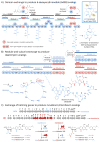Metabolic engineering for the production of natural products
- PMID: 22432617
- PMCID: PMC4077471
- DOI: 10.1146/annurev-chembioeng-061010-114209
Metabolic engineering for the production of natural products
Abstract
Natural products and their derivatives play an important role in modern healthcare as frontline treatments for many diseases and as inspiration for chemically synthesized therapeutics. With advances in sequencing and recombinant DNA technology, many of the biosynthetic pathways responsible for the production of these chemically complex yet valuable compounds have been elucidated. With an ever-expanding toolkit of biosynthetic components, metabolic engineering is an increasingly powerful method to improve natural product titers and generate novel compounds. Heterologous production platforms have enabled access to pathways from difficult to culture strains, systems biology and metabolic modeling tools have resulted in increasing predictive and analytic capabilities, advances in expression systems and regulation have enabled the fine-tuning of pathways for increased efficiency, and characterization of individual pathway components has facilitated the construction of hybrid pathways for the production of new compounds. These advances in the many aspects of metabolic engineering not only have yielded fascinating scientific discoveries but also make it an increasingly viable approach for the optimization of natural product biosynthesis.
Figures



References
-
- Li JWH, Vederas JC. Drug discovery and natural products: end of an era or an endless frontier? Science. 2009;325:161–5. - PubMed
-
- Harvey AL. Natural products in drug discovery. Drug Discov Today. 2008;13:894–901. - PubMed
-
- Newman DJ, Cragg GM. Natural products as sources of new drugs over the last 25 years. J Nat Prod. 2007;70:461–77. - PubMed
-
- Demain AL, Adrio JL. Contributions of microorganisms to industrial biology. Mol Biotechnol. 2008;38:41–55. - PubMed
-
- Stephanopoulos G, Nielsen J, Aristodou A. Metabolic Engineering. San Diego: Academic Press; 1998.
Publication types
MeSH terms
Substances
Grants and funding
LinkOut - more resources
Full Text Sources
Other Literature Sources

